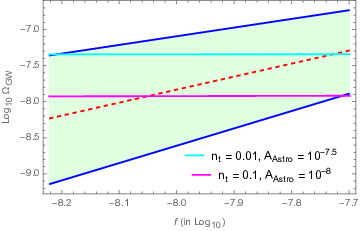Title: Probing The Early Universe Cosmology With NANOGrav: Possibilities and Limitations
Authors: Ido Ben-Dayan, Utkarsh Kumar, Udaykrishna Thattarampilly, and Amresh Verma
Author Institution: Physics Department, Ariel University
Status: Submitted to arXiv
This summer, one of the biggest news stories in astronomy was the announcement of a gravitational wave background (GWB) detection by the North American Nanohertz Gravitational Wave Observatory (NANOGrav). This was corroborated by data from several other pulsar timing array (PTA) experiments: the EPTA, InPTA, CPTA, and PPTA. While the PTA experiments agree on the existence of a nanohertz GWB, astronomers still don’t definitively know what the source is (see this recent bite for a discussion of some of the possibilities).

Among the many possible sources for the signal is inflation, the brief and rapid expansion of space which may have occurred sometime within the first second following the big bang. Inflation is important for resolving several problems in the standard cosmological model, however, it still lacks direct evidence and many possible models have been proposed to describe it. The production of a GWB is a fundamental prediction of inflation, however, and detecting such a signal would provide evidence that it happened. Thus, gravitational wave (GW) astronomers are on the hunt for this signal in GWB data. So far, the search has had some difficulties. Today’s authors investigate the possibility that the NANOGrav signal comes from inflationary GWs.
Don’t forget to reheat!
Today’s paper includes reheating in the analysis of an inflationary, aka ‘primordial,’ GWB signal. The reheating phase is the transition that connects the end of inflation to the phases of the standard big bang cosmology. Including a nontrivial reheating process introduces additional parameters into the analysis which affect the spectrum of the GWB signal. Thus, they should not be ignored to get a full picture of inflation in light of the GWB signal.
The reheating scenarios investigated in this paper fall into three categories described by different equations of state. The equation of state (EOS) is summarized by a dimensionless number, : the ratio between the pressure and density of the universe. The canonical model of reheating has
= 0, and instantaneous reheating is described by an EOS parameter of 1/3. A “stiff” EOS (i.e. one for which pressure increases a lot for a given increase in density, making the fluid harder to compress) is also considered.
The important parameters for the analysis are the EOS (), the temperature of reheating, the tensor-to-scalar ratio (r), and the spectral index (
). The latter two parameters, which describe the amplitude and the frequency dependence of the fluctuations, respectively, are the usual choices for characterizing the spectrum of fluctuations from inflation responsible for primordial GWs observed today.
The authors relate the parameters describing the GWB measured today to the four parameters describing inflation and reheating. They then perform an analysis using the latest NANOGrav data to constrain the primordial (inflation + reheating) parameters from the observed GWB. The analysis suggests a strong correlation between the reheating EOS and the spectral index of the primordial spectrum, meaning that it is important to take the reheating scenario into account in the search for inflationary GW signals.

To LIGO scales
An inflationary GWB is expected to produce GWs over a wide range of frequencies. PTA experiments like NANOGrav only cover the nanohertz region, which is only a fraction of the entire signal that may exist. To understand the full picture, the analysis should be expanded to other frequencies. Fortunately, there are already GW experiments operating at higher frequencies. In particular, laser interferometer experiments like LIGO and Virgo are sensitive to GWs in the frequency range from hertz to on the order of 10 kilohertz, and have already (through non-observation of a GWB signal) placed upper limits on the strength of the GWB at these scales. A problem occurs when the primordial spectrum that fits the NANOGrav data is extrapolated to LIGO scales: the upper limits from LIGO are violated. But don’t rule out an inflationary signal just yet! Today’s authors propose several models that can resolve this issue.
Mixing Backgrounds

The first resolution method considers a mix of astrophysical and primordial GWBs. In this case, the entire signal detected by NANOGrav is the sum of primordial GWs and astrophysical GWs– those produced by astrophysical sources such as merging supermassive black holes. This means that the primordial part may be kept below the LIGO bound, while the full signal agrees with NANOGrav.
Two simple models are considered in this paper: one in which the astrophysical GWB follows the same frequency dependence as the primordial background, and another in which the astrophysical spectrum is constant at all frequencies. These lead to scenarios in which up to 16% or 55%, in the same-frequency and constant-frequency astrophysical spectra cases, respectively, of the total signal may be primordial.
Spectrum on the Run
Another method for bringing the LIGO and NANOGrav constraints into agreement is a running of the primordial spectrum. In the simplest case, it is assumed that the spectral index of the primordial power spectrum is constant over all frequencies. A running spectral index, on the other hand, depends on the frequency. The running, which describes the frequency dependence of the spectral index, is typically considered to be extremely small, and thus insignificant. However, for a large spectral index such as the authors obtained in analyses of the NANOGrav data for the instant reheating case, the running may be large enough to drive the GW amplitude down to a value so small it is unobserved by interferometer experiments like LIGO.
To test this, the authors perform their analyses again with a running spectral index. In the instant reheating case, they find a value of the running which does not violate LIGO bounds. They also find that irrespective of the reheating model, there exists a value of the running that prevents violation of the LIGO bounds.
Don’t rule out a primordial signal
The author’s say not to rule out a primordial explanation for the NANOGrav signal yet. Taking different reheating scenarios into account, allowing for a running of the primordial spectrum, and considering that the detected signal may be the sum of several different backgrounds, could each make a primordial signal more favorable than previously concluded. Future work, including allowing reheating parameters to depend on time and frequency, and incorporating more data sets in the analyses, may yet provide more insight.
Astrobite edited by Karthik Yadavalli
Featured image credit: modified from Christine Daniloff, MIT, ESA/Hubble and NASA & NANOGrav




